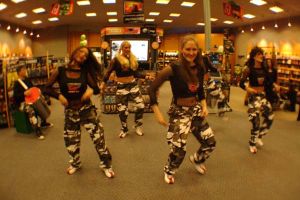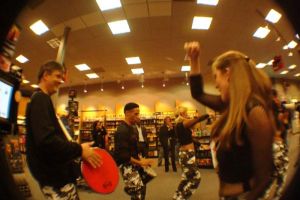|
[Disclaimer:
Stu is not Brazilian, but Texan. If these patterns are not identical
to what they are playing down south in Brazil, they will still,
it is hoped, be useful. We invite our Brazilian brothers and sisters
to contribute an article, a video, and or sound file, as we love
to hear more about your music and your culture. |
. |
This 1st video clip runs through a few basic patterns we have found useful in playing the tantan.
Any of these short patterns is useful either by itself, or in combination with one or more of the others, strung together to make longer patterns and phrases. Here is an example of two such patterns strung together [2 bars each] to make a longer one:
These next three tan tan patterns are based on an important pattern known in Brazil as Partido Alto.
TanTan - Partido Alto 01 - Partido Alto is superimposed atop the "surdo" backbeats, the classic Samba bass drum part..
TanTan - Partido Alto 02 - This one is similar to the first, but with an extra open note in the right hand leading back around to the downbeat.
TanTan - Partido Alto 03 - this pattern has a busier part on the shell reinforcing the downbeat at the beginning and the strong beat just before it.. [on 4 and on 1 if you are counting in a big 4]
The next patterns are based on a universal rhythm, found in many cultures. The rhythm is useful on an incredibly wide array of instruments from all over, including the TanTan. Now, then, these twelve notes, spots, or places in time, form a bridge between 4/4 and 12/8 or between 16 based and 12 based loops. All kind of clave based possibilities arise from within this pattern. It is first demonstrated with all closed notes [click for video]:
12
note pattern
1.&a2.&a3.&a4.&a
R.LRL.RLR.LRL.RL
X.XXX.XXX.XXX.XX
By playing open strokes in the right hand for one or more of these 12 notes, we find a group of useful patterns. Here, for example, we have open notes on "2&" and "4&". These are the same spots that the tumba plays open tones in Guaguanco, so it is a useful pattern playing with congeros, etc.
Now, if we alter the pattern a bit, filling in some of the rests [indicated by dots] with double right hand strokes, we get patterns like this [thumb stroke is lower case]:
you will note that in the basic version, the right hand is playing the part known in cuba as the Tresillo, a pattern known in a great many cultures. [a cycle of 8, grouped 3-3-2, repeated twice in a bar of 4]
1.&a2.&a3.&a4.&a
R..R..R.R..R..R.
X..X..X.X..X..X.
When attempting to give the rhythm more drive, more ongoing energy, it is often useful to play downbeats on the shell, along with the tresillo in the right hand. here are a few example of this, with different notes played open:
[note: in notating these patterns in an HTML text based style, we have been using a red R for right and a blue L for left, we add now PURPLE and the letter 'B' for both hands at once]
say |: one, a two and three, a four and | one, a two and three a four and :|
click the file name for video
These tresillo patterns form an alternative to the backbeat of the Samba patterns. The downbeats in the left hand against the tresillo give the groove plenty of forward energy.. See an example in a live situation. (Apologies for the poor sound, but the camera microphone was in the wrong spot to pick up any low end.)


Len Barnett and I were retained this last fall by Comment US to perform on the MAD CROC energy gum street team, two drummers furnishing the energy and the music for 5 dancers and [in Florda] five actresses as well, who were to pass out energy gum to the crowds, and introduce this product to the target audience [19-25 year olds].
The first night [above], we were at the Gamestop in Plano Texas for the unveiling of the new X-Box 360 Game System. The Gamestop X-box unveiling was sort of a test run for the larger campaign, which was two full days in packed out Gainesville Florida during the Gator Bowl. The dancers had 3 dance routines, all Janet Jackson style hip hop dance. The director and choreographer didn't really want Afro-Cuban or African, they wanted hip hop, which as we all know, is almost always a drum machine or at drumset loop of some sort..kick drum on 1, backbeats (2&4) on snare or claps. We did not want to bring amps, electronics, etc. We knew we'd have to walk a long way and play in the street at various locations. We knew we'd have to fly into Gainesville with our instruments as checked baggage. It was up to us: what would we bring? After trying out a few ideas, we settled on a tan tan and a timba.
It was good that we had the Gamestop gig for a test run. as it turned out, the little timba wasn't enough and the Napa on the TanTan wasn't loud enough, so we switched before Florida, to a 28" x 14" timbau, and we changed the head on the Tantan to a REMO fiberskin. my hand was not loud enough on the shell, so I ended up using a small stick or a tuning wrench, which dogged out the shell a little, but did the trick, soundwise. I would like to use a bell, perhaps a banana bell, next time, with a little steel rod beater..
During the day we stayed near a booth across the street from the stadium and played periodically, alternating with the disk jockey who was kind enough to work with us. At night, both Friday and Saturday, we roamed the bar scene in downtown Gainesville, playing, dancing, and passing out energy gum. As the gig went on, we realized we could do a few bars of Samba, then drop back down into groove A, to good effect. See a video example.
We got a couple of hours of video the street scene in Gainesville that weekend, and we are trying to edit it into usable form. What a truly wild and fun scene it was. This page only scratches the surface of what is possible for tan tan. We encourage those of you out there who are working with Brazilian instruments, whether in a traditional or a non-traditional context, to write us, and send examples if possible.
Kind Regards,
Eric Stuer,
editor & publisher, Rhythmweb
Feb2006